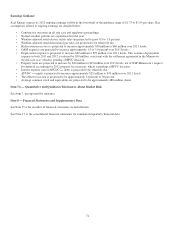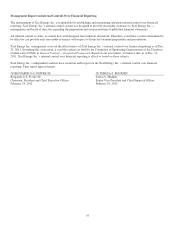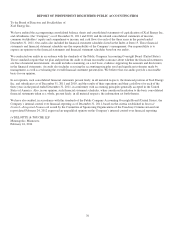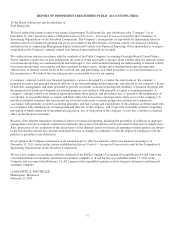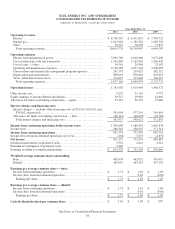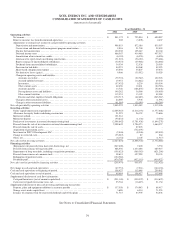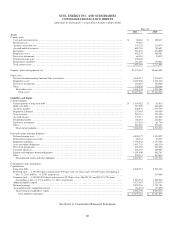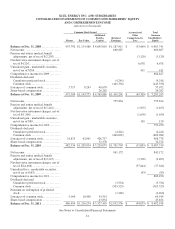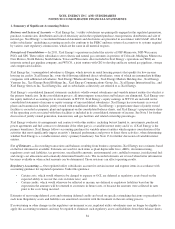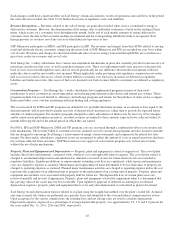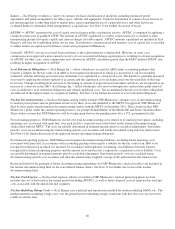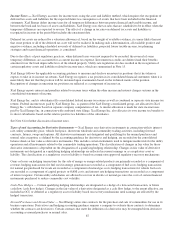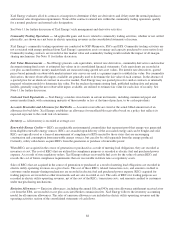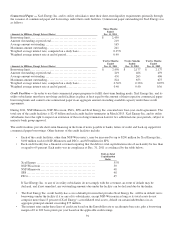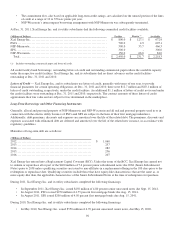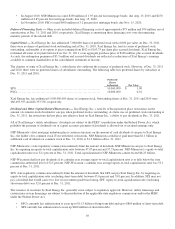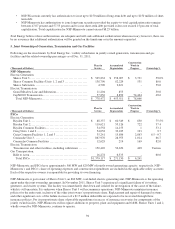Xcel Energy 2011 Annual Report Download - page 94
Download and view the complete annual report
Please find page 94 of the 2011 Xcel Energy annual report below. You can navigate through the pages in the report by either clicking on the pages listed below, or by using the keyword search tool below to find specific information within the annual report.84
XCEL ENERGY INC. AND SUBSIDIARIES
NOTES TO CONSOLIDATED FINANCIAL STATEMENTS
1. Summary of Significant Accounting Policies
Business and System of Accounts — Xcel Energy Inc.’s utility subsidiaries are principally engaged in the regulated generation,
purchase, transmission, distribution and sale of electricity and in the regulated purchase, transportation, distribution and sale of
natural gas. Xcel Energy’s consolidated financial statements and disclosures are presented in accordance with GAAP. All of the
utility subsidiaries’ underlying accounting records also conform to the FERC uniform system of accounts or to systems required
by various state regulatory commissions, which are the same in all material respects.
Principles of Consolidation — In 2011, Xcel Energy’s operations included the activity of NSP-Minnesota, NSP-Wisconsin,
PSCo and SPS. These utility subsidiaries serve electric and natural gas customers in portions of Colorado, Michigan, Minnesota,
New Mexico, North Dakota, South Dakota, Texas and Wisconsin. Also included in Xcel Energy’s operations are WGI, an
interstate natural gas pipeline company, and WYCO, a joint venture with CIG to develop and lease natural gas pipelines, storage
and compression facilities.
Xcel Energy Inc.’s nonregulated subsidiary is Eloigne, which invests in rental housing projects that qualify for low-income
housing tax credits. Xcel Energy Inc. owns the following additional direct subsidiaries, some of which are intermediate holding
companies with additional subsidiaries: Xcel Energy Wholesale Group Inc., Xcel Energy Markets Holdings Inc., Xcel Energy
Ventures Inc., Xcel Energy Retail Holdings Inc., Xcel Energy Communications Group, Inc., Xcel Energy International Inc., and
Xcel Energy Services Inc. Xcel Energy Inc. and its subsidiaries collectively are referred to as Xcel Energy.
Xcel Energy’s consolidated financial statements include its wholly-owned subsidiaries and variable interest entities for which it is
the primary beneficiary. In the consolidation process, all intercompany transactions and balances are eliminated. Xcel Energy uses
the equity method of accounting for its investments in WYCO. Xcel Energy’s equity earnings in WYCO are included on the
consolidated statements of income as equity earnings of unconsolidated subsidiaries. Xcel Energy has investments in several
plants and transmission facilities jointly owned with nonaffiliated utilities. Xcel Energy’s proportionate share of jointly owned
facilities is recorded as property, plant and equipment on the consolidated balance sheets, and Xcel Energy’s proportionate share
of the operating costs associated with these facilities is included in its consolidated statements of income. See Note 5 for further
discussion of jointly owned generation, transmission, and gas facilities and related ownership percentages.
Xcel Energy evaluates its arrangements and contracts with other entities, including but not limited to, investments, purchased
power agreements and fuel contracts to determine if the other party is a variable interest entity and if so, if Xcel Energy is the
primary beneficiary. Xcel Energy follows accounting guidance for variable interest entities which requires consideration of the
activities that most significantly impact an entity’s financial performance and power to direct those activities, when determining
whether Xcel Energy is a variable interest entity’s primary beneficiary. See Note 13 for further discussion of variable interest
entities.
Use of Estimates — In recording transactions and balances resulting from business operations, Xcel Energy uses estimates based
on the best information available. Estimates are used for such items as plant depreciable lives, AROs, decommissioning,
regulatory assets and liabilities, tax provisions, uncollectible amounts, environmental costs, unbilled revenues, jurisdictional fuel
and energy cost allocations and actuarially determined benefit costs. The recorded estimates are revised when better information
becomes available or when actual amounts can be determined. Those revisions can affect operating results.
Regulatory Accounting — Our regulated utility subsidiaries account for certain income and expense items in accordance with
accounting guidance for regulated operations. Under this guidance:
• Certain costs, which would otherwise be charged to expense or OCI, are deferred as regulatory assets based on the
expected ability to recover the costs in future rates; and
• Certain credits, which would otherwise be reflected as income, are deferred as regulatory liabilities based on the
expectation the amounts will be returned to customers in future rates, or because the amounts were collected in rates
prior to the costs being incurred.
Estimates of recovering deferred costs and returning deferred credits are based on specific ratemaking decisions or precedent for
each item. Regulatory assets and liabilities are amortized consistent with the treatment in the rate setting process.
If restructuring or other changes in the regulatory environment occur, regulated utility subsidiaries may no longer be eligible to
apply this accounting treatment, and may be required to eliminate such regulatory assets and liabilities from their balance sheets.


